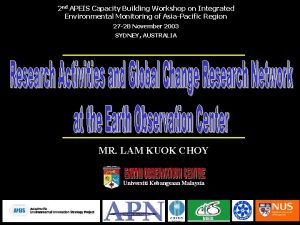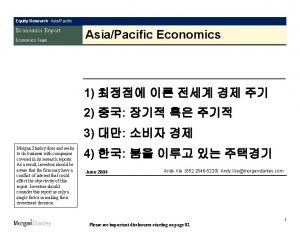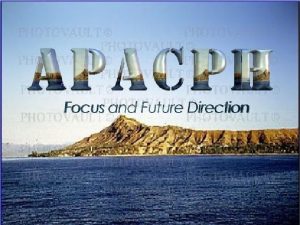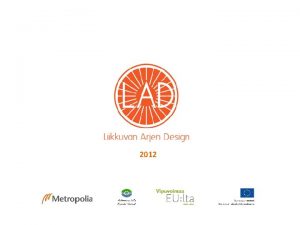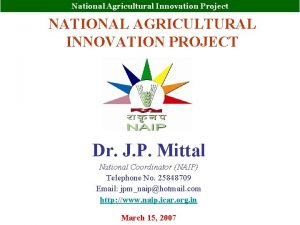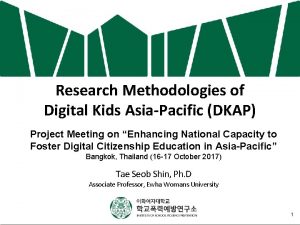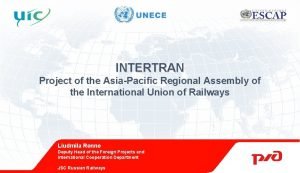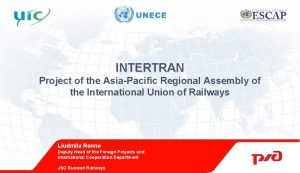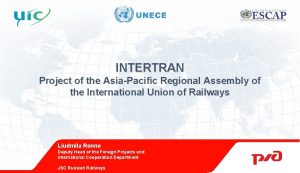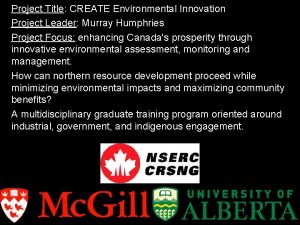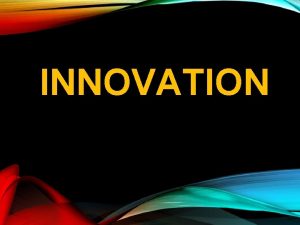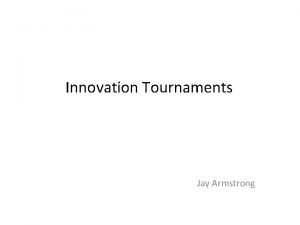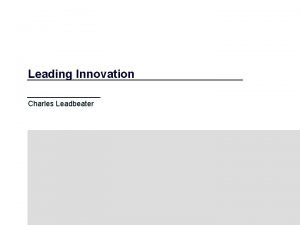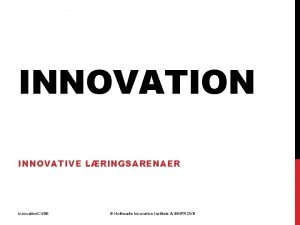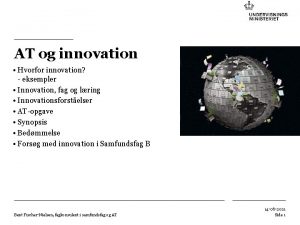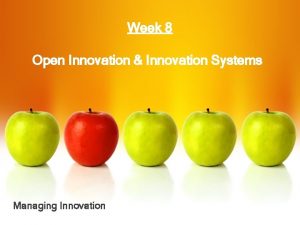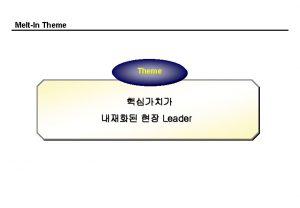AsiaPacific Environmental Innovation Project APEIS Environmental Innovation for








































- Slides: 40

Asia-Pacific Environmental Innovation Project (APEIS) - Environmental Innovation for Sustainable Development - Masataka Watanabe: Leader of Integrated Environmental Monitoring Sub-project Mikiko Kainuma: Leader of Integrated Environmental Assessment Sub-project Hideyuki MORI: Leader of Research on Innovative and Strategic Policy Options Sub-project 3 May 2006 NIES CSD-14 Partnerships Fair – May 2006 3/4/2021 1

Framework of APEIS WSSD Propose Asia-Pacific model ECO ASIA Ministerial Meeting ECO ASIA Panel Scientific database and options Policy Guidance International Scientific Activities International organizations (ADB, UNEP, UNU) Joint project collaboration APN Research on innovative and strategic policy options Sub-projects Integrated Environmental Monitoring Integrated Environmental Assessment Create linkages and cooperative structures Millennium Ecosystem Assessment (MA) and Other international projects 2

Concept / Target • Each sub-project is designed to provide a scientific basis for decision-making and to establish on-going communication between scientists and policy-makers. What has been done. • • • Database Monitoring/Modeling tools Network What next steps? • • What area these tools could be applied further? How to expand collaboration? 3

Sub-Project: Integrated Environmental Modeling (IEM) National Institute for Environmental Studies (NIES) 3/4/2021 4

Integrated Monitoring System Satellite Observation Network MODIS high-order products Land surface temperature Land cover / Vegetation indices Fires & biomass burning Leaf area index / FPAR Photosynthesis / NPP Ecological Indices • Water deficit index • Aridity • Index of desertification • Index of dust storm Ecological GIS Data • Digital maps • Statistic data • Other remote sensing date Ground-truth Measurement • Meteorological data • Hydrological data • Vegetation data • Soil properties data Integrated Model for Assessment of Ecological Function Water resources Carbon cycle Nutrient cycle Food Production and Security Disaster Protection Detection of Ecosystem Vulnerability 5 Contribution to Policy Making for SD

6

(Desert) H: Heat flux LE: Latent heat flux (evaporation rate) (Wheat and corn field)) (paddy field) 7

Estimated water deficit index (EF) and evapotranspiration (ET) of winter wheat field with MODIS remote sending datasets in North China Plain 8

9

10

Application to Regional Scale: Carbon Fixation by Vegetation using MODIS Data Measurements Climatic Factors GIS Input Layers Land Use Carbon Fixation ( Mg C ha-1) Before improved Input Simulation of CO 2 Flux Modeling After improve d Validation Scale-up 11

Leaf Area Index (LAI) Vegetation Index (NDVI) Daily Simulation of Carbon Exchange Net Ecosystem Exchange (NEE) 12

13

Sub-Project: Integrated Environmental Assessment (IEA) National Institute for Environmental Studies (NIES) 3/4/2021 14

Objectives of IEA Developing IEA tools to assess innovative options • Diffusing and applying IEA tools for selected Asia-Pacific countries (China, India, Thailand, Korea) • Developing quantitative innovative scenarios using IEA tools • Link with MDG/national goals and Sustainable Development 15

Tools for Integrated Environmental Assessment (IEA) 16

What kind of issues IEA Tools can address? Issues Considered IEA Tools Examples Integration of millennium development goals, global environmental problems, and sustainability AIM/Material AIM/Energy AIM/Agricult ure India's assessment of innovative options for meeting both millennium development goals and climate change objectives Renewable energy, rural electrification, and municipal solid waste management AIM/Energy AIM/Trend SDB Thailand's and Korea's environmentally sound energy innovations MDG, water, and sanitation AIM/Water AIM/Material SDB Asia-Pacific countries'water and sanitation developments and national health improvements (SDB: Strategic Data. Base) City air pollution AIM/Air Beijing city air management address country-specific management IEA Tools can AIM/Energy China air pollution and 17 various environment and development problems AIM/Material health impact

How to assess national-level climate change scenarios and MDG targets of linkage among global scenarios -India’s case using AIM/Material & AIM/Energy- 18

Water Stress Index (ratio between total withdrawal and renewable water resource) 2000 1 5 10 0 20 Order from Strength 40 60 80 100 ~ (%) 2100 Technogarden 2100 Withdrawal: driven by socio-economic factors Water resource: driven by climate factors General trend of stress index change can be explained by demand side. 19

Role of renewable energy -Thailand’s case using SDB- 20

Visualization of SO 2 Concentration - Air Quality Analysis with AIM/Air - SO 2: Concentration contour of 3 ppb surface 2001/3/31~4/9 UTC 21

Critical air quality locations in Beijing: transport emissions -China’s case using AIM/Air- Simulation of SO 2 concentration caused by traffic emission in Beijing in a winter night 22

Demonstration: Area: the center of Beijing city; Period: Jan 1 st, 2000 ~ Jan 14 th, 2000; Time step: 1 hour; Emission source: automobiles; Traffic pattern: hourly change in a day; Meteorology data: ECMWF; Model: Plume or Puff model for a line of point sources (each 23 point source covers emission from automobiles on road within 100 m x 100 m area)

Contributions of APEIS/IEA APEIS session at CAPa. BLE workshop Capacity building workshop on (Beijing, Sep 2005) model development for Asia-Pacific researchers Transfer of IEA tools to selected Asia-Pacific countries Contributions to international projects: UNEP/SEF II workshop (Hanoi, Jan 2005) ØMA (Millennium Ecosystem Assessment) ØIPCC AR 4 ØUNEP/GEO 3 & GEO 4 ØUNEP[RISO]/Development and Climate Project ØUNEP/SEFII: Great Mekong Project ØEMF (Energy Modeling Forum) ØCAPa. BLE project 24

Sub-Project: Research on Innovative and Strategic Policy Options (RISPO) II Research on the Promotion of Sustainable Development in the Context of Regional Economic Integration: Strategies for Environmental Sustainability and Poverty Reduction Institute for Global Environmental Strategies (IGES) 3/4/2021 25

Implementation scheme • Implemented in conjunction with a partnership project under the United Nations Environment Programme/Network of Institutions for Sustainable Development (UNEP-NISD) • Collaboration with research institutes from six countries in East Asia (China, Indonesia, Japan, Republic of Korea, Thailand, Vietnam) 3/4/2021 26

Overview of RISPO-II p What is considered: • East-Asian economic integration will have significant effects on the environment, poverty and sustainable development in the region. • Increasing the degree of openness without the appropriate environmental policies may exacerbate environmental degradation. p Objective To provide research-based policy options useful for environmental policies within the context of East Asian economic integration. p Geographical focus: ASEAN (10 countries) + 3 (China, Japan, Korea). 6 countries (China, Indonesia, Japan, Korea, Thailand, and Vietnam) have been selected for case studies. p 3 year project: April 2005–March 2008 3/4/2021 27

Research approach Modelling Analysis Economy-wide policy impact assessment using the modified GTAP model and other tools Scenario Approach Accommodate uncertainty in economic integration in East Asia with three scenarios (Shallow, Moderate, Deep) Policy Analysis Deeper analysis of sector/issue specific policies using a range of tools for institutional and policy impact assessment 3/4/2021 Integrated Policy Assessment Examines the economic, social and environmental implications of policy options, by synthesising the results of both economy-wide and sector/issue specific policy assessments. 28

Expected outcome: Strategic Environmental Policy Options Policy-makers have to make decisions to prevent environmental damages caused by economic activities before damages will happen. Scenario analysis is essential to have insights what is going to happen. The development of policy responses that consider trade -offs and principles for policy choices is necessary Scenario-specific policy packages could be provided with their assessment results. Strategic Environmental Policy Options These options will assist policy-makers in developing their “sustainable development policies” with aligning development and environmental risk. 3/4/2021 29

Thank you for your attention! URL: http: //www. ecoasia. org/APEIS E-mail: APEIS@env. go. jp IEM: http: //www-basin. nies. go. jp/english/project/iem/index. html IEA: http: //www-iam. nies. go. jp/aim/apeis/ RISPO: http: //www. iges. or. jp/en/ltp/activity_rispo 2. html E-mail: rispo 2@iges. or. jp 30

31

10 0. 2 5 0 0. 0 2025 2015 2000 35 1. 0 Relative risk of diarrhea mortality Conventional Advanced Technologies Household connection 30 0. 8 25 0. 6 20 Well/Pond/Borehole 15 0. 4 10 0. 2 5 0 Public standpoint Rainwater Sewer connection Septic tank VIP/Simple pit latrine Diarreha 0. 0 50 Year 0 20 15 and reduce the cost. 10 2025 0. 4 2020 15 Management options 100 2015 20 0. 6 2010 25 Management options can reduce leakage 150 of water supply, 2005 0. 8 2000 30 Water supply by household connection (million m 3/yr) 1. 0 Annual cost for HC HC* (billion$/yr) Annual cost (Bil. &/year) 35 Relative risk of diarrhea mortality Assessment of Safe Water/Sanitation Technologies and Management Options - India’s case using SDB - Management options 5 0 2025 2015 2000 2015 2025 32 *HC: Household Connection

Assessment of Air Pollution and Health Impact - China’s case using AIM/Material - 33

Messages from IEA -Integrated Environmental Assessment 1. IEA tools are designed to assess policies to achieve MDG & national targets. 2. Technology and institution innovations are key to address environment and development trade-offs. 34

Messages from IEA -Integrated Environmental Assessment 3. Quantitative assessment can provide information and insights for making innovative choices delivering cobenefits 4. IEA tools link science and policy and improve effectiveness of policy-making. Further Information: http: //www. ecoasia. org/APEIS/iea/ http: //www-iam. nies. go. jp/aim/index. htm 35

Overview of RISPO-II p Hypothesis • East-Asian economic integration will have significant effects on the environment, poverty and sustainable development in the region. • Increasing the degree of openness without the appropriate environmental policies may exacerbate environmental degradation. p Objective To provide research-based policy options that will be useful contributions to the development of environmental policies by decision-makers, within the context of East Asian economic integration. p Geographical focus: ASEAN (10 countries) + 3 (China, Japan, Korea). 6 countries (China, Indonesia, Japan, Korea, Thailand, and Vietnam) have been selected for case studies. p 3 year project: April 2005–March 2008 3/4/2021 36

Research Innovation Assess environmental impacts of trade policies Most existing studies on trade and environment Develop environmental policy packages dealing with the environmental impacts Some studies include this, without taking into account economy-wide impact of proposed policies Assess economic, social and environmental outcomes (impacts) of implementing policy packages, and feed back to policy development Innovative apporoach, which is necessary for sustainable development 3/4/2021 37

Primary outcomes Outcomes of Policy Analysis p Sector/issue specific policy packages with a wide variety of policies p Policy impact assessment of the policy packages p Institutional assessment results addressing implementability of the policy packages Outcomes of Modelling Analysis p Economy-wide policy packages with a limited range of policies p Environmental, social and economic indicators for each country, such as CO 2 emission, BOD discharge, national GDP, unemployment rate, and the poverty ratio p Evaluation results of economy-wide policy packages based on policy targets, such as CO 2 emission reduction and non-declining GDP 3/4/2021 38

Critical air quality locations in Beijing: transport emissions -China’s case using AIM/Air- Simulation of SO 2 concentration caused by traffic emission in Beijing in a winter night 39

Deposition of SO 42 - in July 40 (kg/hectare/month)
 Apeis
Apeis Mysite.socccd
Mysite.socccd Disruptive and radical innovation
Disruptive and radical innovation Fspos
Fspos Typiska novell drag
Typiska novell drag Tack för att ni lyssnade bild
Tack för att ni lyssnade bild Ekologiskt fotavtryck
Ekologiskt fotavtryck Varför kallas perioden 1918-1939 för mellankrigstiden
Varför kallas perioden 1918-1939 för mellankrigstiden En lathund för arbete med kontinuitetshantering
En lathund för arbete med kontinuitetshantering Underlag för särskild löneskatt på pensionskostnader
Underlag för särskild löneskatt på pensionskostnader Tidbok
Tidbok Sura för anatom
Sura för anatom Förklara densitet för barn
Förklara densitet för barn Datorkunskap för nybörjare
Datorkunskap för nybörjare Tack för att ni lyssnade bild
Tack för att ni lyssnade bild Debattinlägg mall
Debattinlägg mall För och nackdelar med firo
För och nackdelar med firo Nyckelkompetenser för livslångt lärande
Nyckelkompetenser för livslångt lärande Påbyggnader för flakfordon
Påbyggnader för flakfordon Vätsketryck formel
Vätsketryck formel Publik sektor
Publik sektor Urban torhamn
Urban torhamn Presentera för publik crossboss
Presentera för publik crossboss Teckenspråk minoritetsspråk argument
Teckenspråk minoritetsspråk argument Vem räknas som jude
Vem räknas som jude Klassificeringsstruktur för kommunala verksamheter
Klassificeringsstruktur för kommunala verksamheter Fimbrietratt
Fimbrietratt Claes martinsson
Claes martinsson Centrum för kunskap och säkerhet
Centrum för kunskap och säkerhet Verifikationsplan
Verifikationsplan Bra mat för unga idrottare
Bra mat för unga idrottare Verktyg för automatisering av utbetalningar
Verktyg för automatisering av utbetalningar Rutin för avvikelsehantering
Rutin för avvikelsehantering Smärtskolan kunskap för livet
Smärtskolan kunskap för livet Ministerstyre för och nackdelar
Ministerstyre för och nackdelar Tack för att ni har lyssnat
Tack för att ni har lyssnat Hur ser ett referat ut
Hur ser ett referat ut Redogör för vad psykologi är
Redogör för vad psykologi är Matematisk modellering eksempel
Matematisk modellering eksempel Tack för att ni har lyssnat
Tack för att ni har lyssnat Borra hål för knoppar
Borra hål för knoppar









































